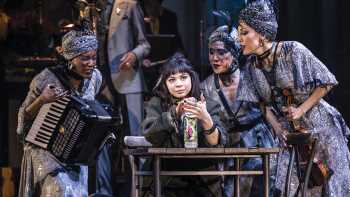“Hadestown’s” 12-year journey to Broadway was an odyssey in its own right.
Singer-songwriter Anaïs Mitchell’s buzzy musical, a folk-operatic retelling of the Greek myth of Orpheus, a musician who ventures to the underworld to rescue his fiancée, Eurydice, was in development for more than a decade before arriving on the New York stage.
The show had humble beginnings, starting as a DIY theater project in Mitchell’s home state of Vermont before becoming a concept album that developed a rabid fan base. It took on new life as an Off Broadway production, making stops in Edmonton and London before finding a home on the Great White Way. The reward for all that perseverance came when Tony Award nominations were announced last month. “Hadestown” picked up a leading 14 nods, including one for best musical.
“I feel so proud to be embraced by that whole world with a piece that comes from the wild woods and not from a boardroom,” Mitchell says. “It feels like a win for people who are taking the unconventional path with their art.”
Rachel Chavkin, the Tony-nominated director of “Natasha, Pierre & the Great Comet of 1812,” played a major role in helping Mitchell adapt the show for New York audiences. That involved writing, rewriting and adding music to make the production more digestible.
Initially, Chavkin says, “Hadestown” lacked narrative momentum. “People were like, ‘The music is freaking great, but what’s happening?’” she says. “We still needed to get to know the characters better. [The musical] grew very, very slowly, and that’s why it feels so organic and so careful.”
Of the show’s earlier incarnation, Mitchell says, “It was more abstract, and the audience had to fill in a lot more blanks. The first phase with Rachel was identifying what felt like missing story pieces.”
Mitchell took inspiration from sung-through musicals like “Les Misérables,” “Sweeney Todd: The Demon Barber of Fleet Street” and “Hamilton” to enhance the storytelling “without breaking the poetry of what worked about it as an abstract piece.” She wrote more than a dozen new songs that helped strengthen the storyline and develop the relationships between characters.
The evolution of “Hadestown” extends far beyond just the sound. In between its run at the intimate 199-seat New York Theater Workshop and landing at the Walter Kerr Theatre on Broadway, which houses approximately 1,000 ticket buyers, the production got a whole new look.
“I wanted the visuals to be as beautiful and poetic as the music is, but it shouldn’t overlap,” Chavkin says. “The visuals don’t need to do what the music is already doing.”
While “Hadestown” was bopping around North America and across the pond, social media helped the show assume a strong presence online. A cast album introduced a global audience to the familiar story of a man who will do anything for the woman he loves.
“There’s so much beauty [in the fact] that music can travel the world on its own legs,” Mitchell says. “People who don’t have money to buy a record, much less pay what it costs to see a Broadway show, have access to that music and have been able to pass it around.”
A lot has changed over the course of the past decade. Mitchell began working on “Hadestown” in 2006, when Paris Hilton and Nicole Richie dominated tabloids and Brangelina was Hollywood’s “it” couple. George W. Bush was president and Donald Trump was the host of a reality TV series called “The Apprentice.” “I remember there being a moment when Bush got reelected, coming up against the reality that maybe this is what the world is,” Mitchell recalls. “A lot of those themes made their way into the show.”
The world certainly looks a little different now, but the play’s examination of politics and capitalism helps make the ancient myth feel relevant to the present day.
“It’s a story about a leader who maintains their power by keeping us apart and making us feel alone and isolated and terrified. That is very familiar,” Chavkin says. “At the same time, people are moved by the idea that there’s hope in the act of simply retelling the story again.”
One song that Mitchell wrote in 2006 — titled “Why We Build the Wall” — found another meaning years later when Trump’s anti-immigration platform centered on building a barrier on the Mexican border. In the dark hellscape of Hadestown, the wall is meant to keep people in the underworld.
Hades, god of the dead, closes out the first act with a call-and-response not unlike something one might hear at a Trump rally. “How does the wall keep us free?” he asks. The workers answer: “The wall keeps out the enemy.”
“I really feel a chill go through the theater,” says Chavkin. “The song is so clear in what it’s doing. I feel people every night quite taken aback by it.”
That universality is in part why the tragic love story of Orpheus and Eurydice resonates.
“It doesn’t have a Hollywood ending,” Mitchell notes. “In a way, that’s why people keep coming back to it. It has a riddle people are trying to solve or dance around. Orpheus is a hero, not because he wins but because he tries.”
Source: Read Full Article

